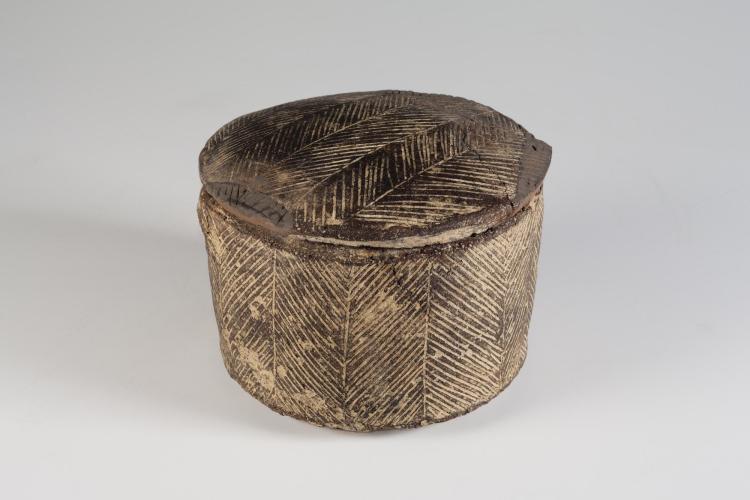Minoan Pottery
 Introduction
Introduction

The peoples who lived on the island of Crete during the Bronze Age are known today as the Minoans, after Minos, a legendary king of Crete. The history of Minoan Crete is broken into Early, Middle, and Late Minoan periods, and although the exact dates for narrower subdivisions are debated, the broad chronological dates for these major periods are largely agreed upon (1).
Early Minoan Period (c. 3,000-2,000 B.C.E.)
Among the earliest Early Minoan pottery types is Incised Ware, characterized by incised decoration of parallel lines creating patterns on the surface of the clay. Contemporary with Incised Ware is Aghios Onouphrios Ware, a type simply painted with dark red or black diagonal lines, which form both series of parallel lines and criss-crosses on a light surface; these designs typically appear on jugs and bowls (2). Vasilike Ware, with its mottled surface achieved by novel means of firing, was probably meant to approximate more substantial and expensive stone vessels. A reddish coat of paint increased the stone-like appearance of Vasilike Ware vessels. At this time, vessels carved of such variegated and colorful stone as serpentine and alabaster are indeed known (3).
The CU Art Museum's collection contains one vessel from the Early Minoan period, an incised pyxis with its lid intact.
Middle Minoan Period (c. 2,000-1,550 B.C.E.)
Pottery in the Middle Minoan Period was transformed by the introduction of the fast potter's wheel, an innovation that led to thinner and finer wares, which, in turn, led to finer decoration. Kamares Ware is decorated with abstract designs, often in complex patterns. Kamares Ware decoration is light-on-dark polychrome and sometimes includes animal or figural representations rather than abstract patterns. The same types of patterns are found on a much thinner type of vessel known as eggshell ware because of its extreme delicacy and fineness (4). An incredible variety of designs adorned the vases of the Middle Minoan period though eventually the energy of the earlier Kamares Ware calmed a bit, becoming more formal with the introduction of repeated vegetal motifs and other nature-inspired designs (5).
Late Minoan Period (c. 1,550-1,100 B.C.E.)
The Late Minoan period brought the famous fresco paintings of the several palatial centers on the island. Well-known themes in Minoan fresco painting include fanciful floral arrangements, heavily adorned women and men, shrines and other religious motifs, and, perhaps most well-known, acrobats or athletes leaping over a bull. Not suprisingly, some of the most decorative ceramic types also come from the Late Minoan period. During this later period of Minoan history, dark-on-light pottery predominated, replacing the earlier polychrome, light-on-dark wares. The Floral Style was one early result of this shift, featuring vases covered in repeated decorative floral motifs. A simliar and contemporary style was the Pattern Style, which covered vessels in geometric designs, rather than florals. The patterns may have been inspired by the borders of fresco paintings in the great palaces (6). Slightly later in date came the delightful Marine Style, which exhibited sinuous octopuses, realistic fishes, dancing dolphins, and speeding nautiluses, as well as jagged, spiky seaweed nad rocks.
Following the Marine Style in the middle of the Late Minoan period was the so-called Palace Style, in which the earlier decorative motifs of plants, flowers, and sea life are arranged symmetrically and in a greatly stylized manner (7). This change from the exuberant Marine and Floral Styles to the more formalized and symmetrical Palace Style is often seen as evidence that Mycenaean Greeks, who originated on the mainland, occupied Crete and imposed their stylistic sensibilities on the native Minoan art (8). At the end of the Late Minoan period came the destruction of the Minoan palaces, after which the mainland would become the center of artistic production in Greece.
This essay was written to accompany a collection of Greek artifacts at the CU Art Museum.
Footnotes
- The dates used in this article are drawn from John G. Pedley, Greek Art and Archaeology (Upper Saddle River, N.J.: Prentice Hall, 1993): 29.
- Jeremy B. Rutter, Prehistoric Archaeology of the Aegean (http://www.dartmouth.edu/~prehistory/aegean/), accessed 01 February 2019; Pedley, Greek Art and Archaeology: 30, fig. 1.8.
- On Vasilike Ware, see Philip P. Betancourt, Vasilike Ware: An Early Bronze Age Pottery Style in Crete (Göteborg: Paul Åströms Forlag, 1979); see also Pedley, Greek Art and Archaeology: 32-3, fig. 1.6.
- Rutter, Prehistoric Archaeology of the Aegean.
- Pedley, Greek Art and Archaeology: 52-5.
- Pedley, Greek Art and Archaeology: 76.
- For pottery of the Late Minoan period see William R. Biers, The Archaeology of Greece (Ithaca, NY: Cornell University Press, 1980): 50-52.
- Pedley, Greek Art and Archaeology: 78.

